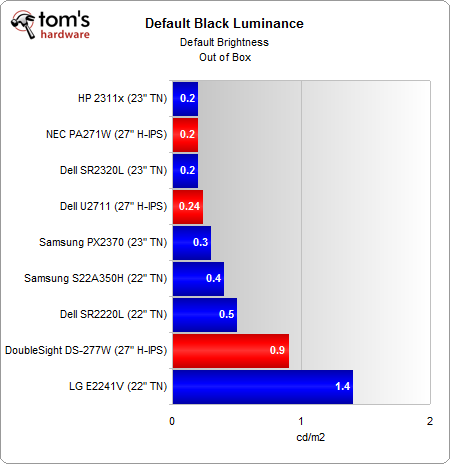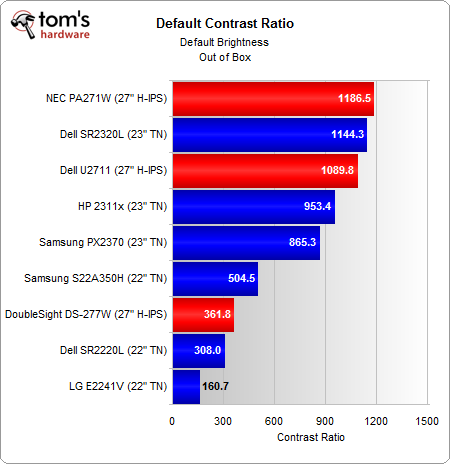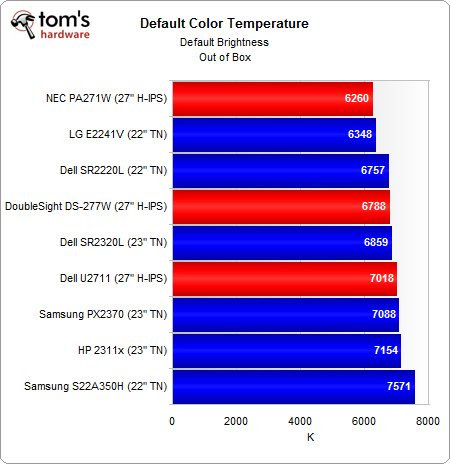Three 27" IPS LCDs: UltraSharp U2711, DS-277W, And MultiSync PA271W
Out-Of-Box Performance: Brightness And Contrast Ratio
Right out of the box, all three 27" IPS-based displays perform rather well in producing bright whites. DoubleSight's DS-277W leads the pack, but then it yields very poor blacks, which is why it suffers when we calculate contrast ratios.
NEC's PA271W surprises us here because it's preset for 220 cd/m2 and we get a reading of 212.3 cd/m2. It's rare to find an OSD menu that uses a nonrelative scale (0 to 100). But NEC's accuracy is refreshing. Even though it's spec'ed for a 1000:1 contrast ratio, we're getting nearly 1200:1 thanks to deep black production on par with HP's TN-based 2311x.
Likewise, Dell's UltraSharp U2711 performs well thanks to good black production.
Brightness can have an effect on how you perceive color. It can also help the display achieve brighter colors. But brightness often sacrifices contrast if a monitor has a poor color palette, which is why we measure that as well.
There's a relatively wide range of default color temperatures between our three 27" monitors. At its Standard Profile setting, Dell's U2711 operates with a slightly cool temperature (7018 K), while DoubleSight's DS-277W and NEC's PA271W are closer to approximating 6500 K.
If you want a balanced image, you'll need to calibrate the display to 6500 K. Most DVDs, digital cameras, and online videos are calibrated for a 6500 K white point, because this represents the spectrum you would see in overcast daylight. So, we do that too.
Current page: Out-Of-Box Performance: Brightness And Contrast Ratio
Prev Page Our Benchmarking Approach Next Page Out-Of-Box Performance: Color Accuracy And GamutGet Tom's Hardware's best news and in-depth reviews, straight to your inbox.
-
terr281 What monitors to review next?... As many people said in the review of the 22" TN panels from your last review, the next review should include "enthusiast available" ~23" panels. (Instead of just big box "Buy from Best Buy" models.)Reply
The lowest price of the three 22" TN panel monitors you reviewed was $180. A quick Newegg search shows several similar panels from names such as Acer, Asus, etc. starting at $140. (And, in the gaming, as well as office environments, 2 or 3 monitors are now more common than one single large one.)
-
nevertell IPS vs VA in gaming.Reply
Although just a regular sum up of the available 22-24 VA panels would be great. -
Thank you for the excellent and thorough review. Perhaps next time, the new Apple 27" Thunderbolt display can be thrown into the mix. For a lot of video and photography pros like myself, the Apple display is considered to be the "standard" and I would love to see how it stacks up again the competition. Also maybe throw in a professional level Eizo display as well to show the difference between a ~$1000 display and a $3000 display.Reply
-
120hz monitors lead the wayReply
You should review a 2560x1600 120hz IPS monitor.
Oh wait...
2560x1600 isn't supported at 120hz over DVI-D (dual link)
IPS monitors can't do 120hz with today's technology
Bummer!
:(
F -
agnickolov I'd recommend the same IPS review applied on affordable 24-26" monitors that most of us would actually potentially buy. It's nice to dream about 27"+ 2560x1440, but let's get back to reality with 24" 1920x1080 and 1920x1200 (if still available) IPS monitors please. (At least until higher resolutions enter mainstream price points.)Reply -
crisan_tiberiu I have a 22" Philips LED Backlight monitor and i am very happy with it . I dont see any Philips monitors in any of your reviews, why is that? :)Reply -
boletus Nice roundup, it had me measuring what a 26" wide monitor would look like on my desk. However, you need to fix the title block in the table for the NEC monitor on the "Black And White Uniformity" page (it says Samsung S22A350H).Reply -
soccerdocks On the "Black And White Uniformity, Viewing Angles" page the 3rd table states that it is for the Samsung S22A350H when it is actually for the NEC.Reply -
Thank you for this comparison, very interesting reading!Reply
I am somewhat disappointed that 27" monitors nowadays don't use 2560*1600 panels.
That resolution makes much more sense to me for a monitor that is not targetted at the average consumer.
Personally I would love a 2560*1920 (or 2048) screen @ 120Hz, but if I understand correctly link speed becomes an issue here.
Why is it that displays for mobile phones are increasing in pixel density, but desktop displays don't improve in this regard?
For a next review I would really like to get a better understanding of (high-resolution) 120Hz monitors. What are the (dis)advantages of 120Hz for regular/2D usage, etc...



